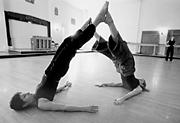BEING A CARETAKER means you care for something, protect it, but don’t necessarily alter it. This is fine if you’re looking after a painting or a building, but it’s less simple if the object of care is dance, where movement equals change. Whether you’re talking about an institution or a tra- ditional form, sometimes the best way to take care of the past is to let the present reshape it.
Intimate Works
May 6-7 at Dance on Capitol Hill
Northwest Invitational Hula Festival
May 5-6 at Tyee High School, SeaTac
Dance on Capitol Hill, the warm-hearted, low-ceilinged studio and performance space founded by Shirley Jenkins 16 years ago, has already seen a number of transitions. Teachers and students have come and gone, but the studio has kept its mandate as a home for generative artists and a jumping-off place for newcomers to the community. With programs such as ChoreoFest in the autumn and Intimate Works in progress this week, DoCH plays host to a variety of artists—from emerging choreographers to established groups—all while continuing to offer a wild menu of classes.
The current lineup for Intimate Works is an example of this variety: Crispin Spaeth and Amii LeGendre, both coming off recent performances at On the Boards, share a program with Alethea Adsitt, Carla Barragᮬ Bryan Dawbin, Wen Yun Melody Li, Rockhopper Dance, and Deborah Wolf. Although these artists are at various places in their development, some with significant experience and others at the beginning of their careers, DoCH offers all of them a stage and some lights to see it by.
Like several other midsized organizations in town though, DoCH leads a precarious life. With wages and taxes to pay on top of a continuing revenue deficit, not to mention the specter of local real estate prices hovering just offstage, another bad winter season like last year—which kept students home with the flu instead of in the studio dancing—could close the doors permanently. Director David Sparenberg is hoping to get through this rough spot by adding even more to the mix, building on the growing world dance presence at the studio. “We want to tap into people’s sense of their ethnic heritage” with programs like this winter’s World Dance Festival, which included contemporary and traditional dances from around the globe. In this case, the best way to keep the place stable may be to keep changing it.
ONE OF THE CHALLENGES of working with an ethnic dance form is to honor its traditions while keeping it from becoming museum fodder. Preservation is particularly hard when the dance form was outlawed for almost an entire generation, as hula was by the white missionaries who came to the Hawaiian Islands in the 1820s. With that kind of disruption in the heritage, it would be understandable if the current group of Kumu Hula, or hula teachers, insisted on an undeviating loyalty to traditional dances. Instead, they’ve chosen to follow an interesting double pathway, reflected in the programming for this weekend’s Third Annual George Naope Northwest Invitational Hula Festival.
The festival opens Friday evening with the hula kahiko, or ancient hula, performed to chants that tell the old stories of the gods, usually in honor of Pele, the goddess of the volcano (not of soccer). The rhythmic chants give the complex, gestural language a percussive edge, which signifies Pele’s jealousies and reprimands of the human race. On Saturday festival organizers will focus on the hapa haole, or half-white hula that reigned from the 1920s to the ’50s. This version, with its creolized Hollywood connotations, sometimes comes off as an insult to serious hula practitioners. But a general awareness of the hula expanded during these decades, so organizers Makanaokalani, Kathy Kapua, and Anela Lemanu don’t feel they can turn their backs on “My Honolulu Gal” and “Lovely Hula Hands.” By claiming this part of their heritage they enable its continuity.









